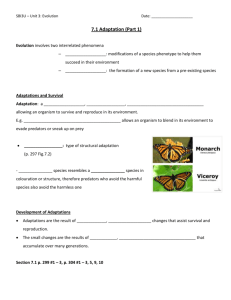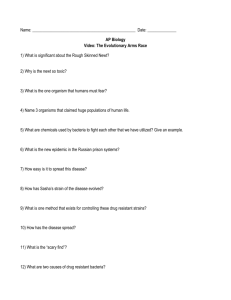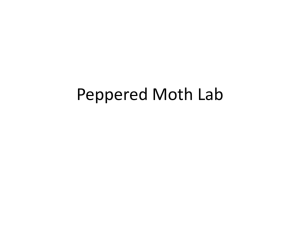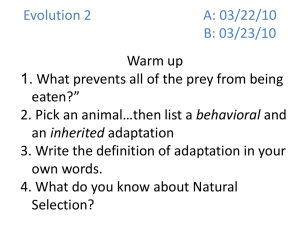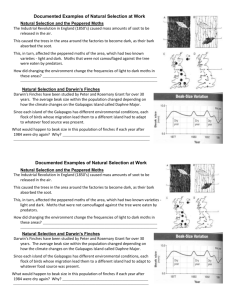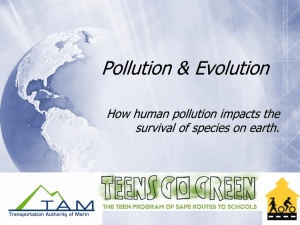Teacher notes and student sheets
advertisement
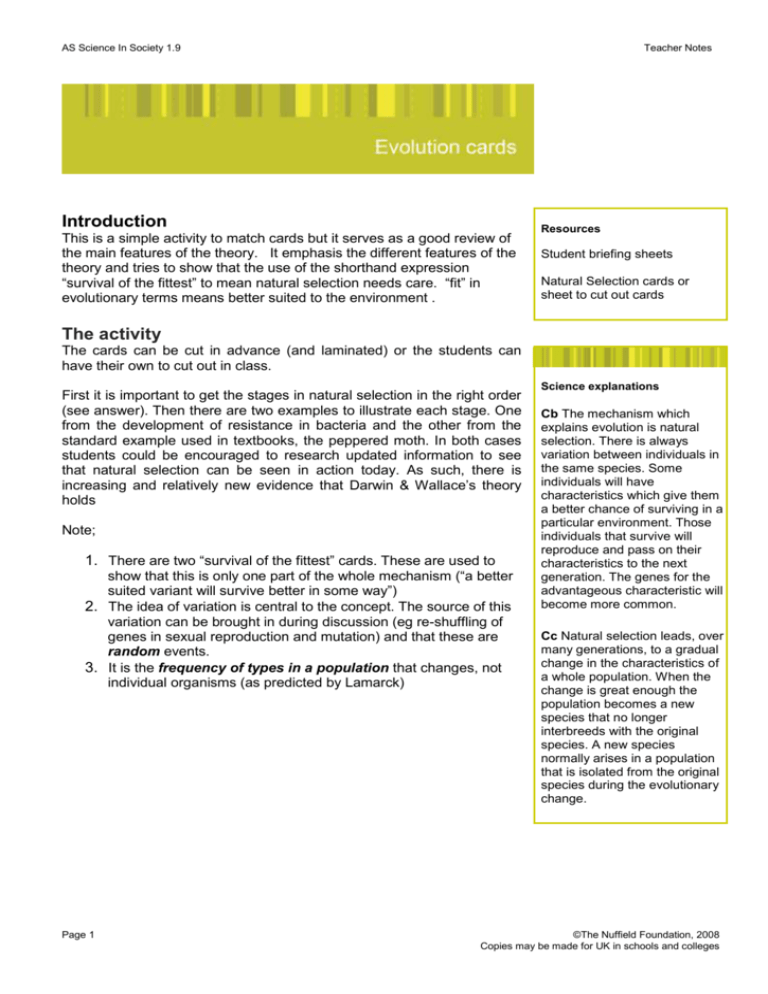
AS Science In Society 1.9 Teacher Notes Introduction This is a simple activity to match cards but it serves as a good review of the main features of the theory. It emphasis the different features of the theory and tries to show that the use of the shorthand expression “survival of the fittest” to mean natural selection needs care. “fit” in evolutionary terms means better suited to the environment . Resources Student briefing sheets Natural Selection cards or sheet to cut out cards The activity The cards can be cut in advance (and laminated) or the students can have their own to cut out in class. First it is important to get the stages in natural selection in the right order (see answer). Then there are two examples to illustrate each stage. One from the development of resistance in bacteria and the other from the standard example used in textbooks, the peppered moth. In both cases students could be encouraged to research updated information to see that natural selection can be seen in action today. As such, there is increasing and relatively new evidence that Darwin & Wallace’s theory holds Note; 1. There are two “survival of the fittest” cards. These are used to show that this is only one part of the whole mechanism (“a better suited variant will survive better in some way”) 2. The idea of variation is central to the concept. The source of this variation can be brought in during discussion (eg re-shuffling of genes in sexual reproduction and mutation) and that these are random events. 3. It is the frequency of types in a population that changes, not individual organisms (as predicted by Lamarck) Page 1 Science explanations Cb The mechanism which explains evolution is natural selection. There is always variation between individuals in the same species. Some individuals will have characteristics which give them a better chance of surviving in a particular environment. Those individuals that survive will reproduce and pass on their characteristics to the next generation. The genes for the advantageous characteristic will become more common. Cc Natural selection leads, over many generations, to a gradual change in the characteristics of a whole population. When the change is great enough the population becomes a new species that no longer interbreeds with the original species. A new species normally arises in a population that is isolated from the original species during the evolutionary change. ©The Nuffield Foundation, 2008 Copies may be made for UK in schools and colleges AS Science In Society 1.9 Teacher Notes Answers Event in the theory Bacterial resistance Peppered moth A population of organisms shows variation. In bacteria, some individuals may be resistant to antibiotics and some not resistant to antibiotics. Polymorphism in Peppered Moths; some dark (“melanic”) and some peppered. One variant may be better suited to the environment than others, especially if the environment changes. Resistant bacteria will not be affected by antibiotics used to combat an illness Camouflaged moths (e.g. dark form on sooty trees) preyed on less, especially if trees have become black with industrial soot A better suited variant will survive better in some way “Survival of the fittest” “Survival of the fittest” The variant which survives better will reproduce more during its lifetime so passing on the genes which produce the variation. Resistant bacteria live longer or divide faster / non resistant may die or be less able to divide Camouflaged moths live longer so reproduce more. Therefore, more of this variant will be produced in the next generation (compared to other variants). More resistant bacteria will be produced (resistance gene passed on) More of camouflaged moth variant will be produced (e.g. more of melanic form/melanic gene passed on) The frequency/percentage of the better suited variant will increase in the population Frequency of resistance in bacteria will increase. Frequency of camouflaged moths (e.g. melanic) will increase. November 2008 Page 2 ©The Nuffield Foundation, 2008 Copies may be made for UK in schools and colleges AS Science In Society 1.9 Student sheets Introduction Several people before Charles Darwin were considering the idea of evolution but Darwin (and Alfred Wallace) was the first to suggest a detailed way for evolution to take place; one which fitted all the evidence he and others had gathered. This was the theory of evolution by natural selection. Many people summarise it as “survival of the fittest” but this is only part of the story. The activity If necessary, copy and cut out the activity cards 1. Put the “event” cards in the correct order to explain natural selection 2. Match the examples from bacterial resistance to each event and do the same for the peppered moth example 3. Where do you put the “survival of the fittest” cards? Think carefully about this term – it is often misused (to mean natural selection). Notice how it is only one aspect of the idea. 4. The final card shows how a change could occur: this would be evolution and it could even give rise to new species. Page 1 ©The Nuffield Foundation, 2008 Copies may be made for UK in schools and colleges AS Science In Society 1.9 Student sheets Copy and cut out these cards FIRST – SECOND – LASTLY – Put the “event” cards in the correct order to explain natural selection Match the examples from bacterial resistance to each event and do the same for the peppered moth example Where do you put the “survival of the fittest” cards? Think carefully about this term – it is often misused (to mean natural selection) Peppered moth Event in the theory Bacterial resistance One variant may be better suited to the environment than others, especially if the environment changes. Resistant bacteria live longer or divide faster / non resistant may die or be less able to divide Camouflaged moths live longer so reproduce more. The frequency/percentage of the better suited variant will increase in the Frequency of resistance in bacteria will increase. Polymorphism in Peppered Moths (some melanic and some peppered) The variant which survives better will reproduce more during its lifetime so passing on the genes which produce the variation. Resistant bacteria will not be affected by antibiotics used to combat an illness Frequency of camouflaged moths (e.g. melanic) will increase. A population of organisms shows variation. In bacteria, some individuals may be resistant to antibiotics and some not resistant to antibiotics. Camouflaged moths (e.g. dark form on sooty trees) preyed on less, especially if trees have become black with industrial soot A better suited variant will survive better in some way More resistant bacteria will be produced (resistance gene passed on) More of camouflaged moth variant will be produced (e.g. more of melanic form/melanic gene passed on) Therefore, more of this variant will be produced in the next generation (compared to other variants). “Survival of the fittest” “Survival of the fittest” Page 2 ©The Nuffield Foundation, 2008 Copies may be made for UK in schools and colleges
